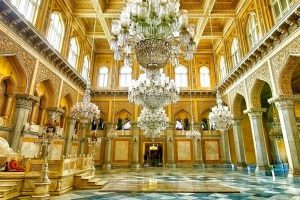The previous darbar hall at the Chowmahalla Complex was used with great care during the rule of Asaf Jah II to that of Asaf Jah VI. Mir Osman Ali Khan Asaf Jah VII used the darbar hall for a years before deciding to build a grand new one. He commissioned the new darbar hall in August 1912, and the construction was completed in 1916.
Greatly inspired by Persian architecture, the Khilwat Mubarak was designed with elements of the royal palaces of Tehran, and many other places. The elements came together in a new light at Khilwat, blending Turkish, Iranian, Qutb Shahi and Mughal influences and styles. The double-height darbar hall is surrounded by open verandahs on higher levels to serve as viewing galleries.
The darbar hall of the Khilwat has a rich Turko-Iranian setting. A Mughal garden spreads out in front, surrounded by tall palm trees. Fountains gush in their midst. White marble steps lead up to the hall through Mughal-style cusped arches. Past the three rows of pillars, the marble hall stands enclosed on three sides and open on one. Spacious galleries were reserved for the ladies of the court to watch the court ceremonies. From the ceiling hangs glass chandeliers, shimmering with ornate floral designs, always brightly lit for the nightly darbars. At the far end of the large hall, sits a grand marble takth (throne), facing the entrance. The takth (throne) is inspired by Mughal designs and architecture. – The Royal Palaces of the Nizams, Dr. M.A. Nayeem
The construction work on Khilwat and the ancillary palaces of the Chau Mahal Complex began on 2nd September 1912. Mir Asaf Jah VII inaugurated Khilwat at 10PM on Friday, 28th January, 1916. It stands today, a proud and resplendent emblem of the labour of thousands of workers, the creativity of the Nizam VII and his team of designers and engineers, and the gorgeous legacy of the Nizams.
